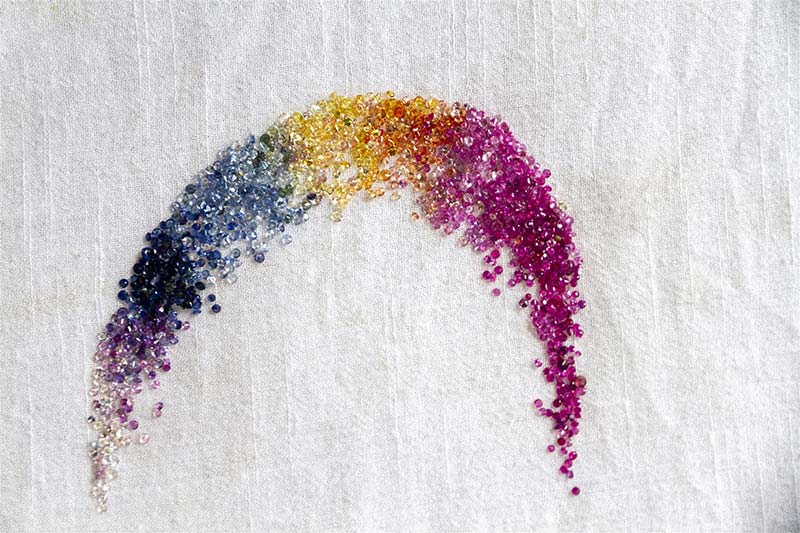Sapphire Engagement Ring Guide | Rare Carat
Who Has a Sapphire Engagement Ring
The famous De Beers slogan “a diamond is forever” might have been conceived in 1947, but the tradition of the engagement ring extends back many centuries, and the use of diamonds was not always the first choice of stone. Thanks to their beauty, versatility, and durability, sapphires have long been amongst the most desired of gemstones. Today, they are considered one of the “Big Three” colored stones along with rubies and emeralds. In fact, one of the most famous engagement rings of all time (by that, of course, I mean that worn by the late Princess Diana and now by her daughter-in-law Duchess Kate) features a show-stopping blue sapphire.
History of Sapphire Engagement Rings
From a practical standpoint, sapphires are a great choice for engagement rings because they are second only to diamonds in their hardness and can handle everyday wear. They are the birthstone for the month of September and thus, may already have significance for many people. Historically, sapphires embodied the virtues of honesty and fidelity. Additionally, the simple act of wearing a sapphire was thought to elevate and enhance the positive qualities of the wearer. In medieval Europe, sapphires were worn as protective amulets to shield the wearer from the ill intentions of others. Moreover, it was thought that the stones were able to counteract the effect of some poisons. That’s a lot of positive energy for a single stone!

Are Sapphires Rare
Today, sapphire supplies are abundant, and are broadly divided into three quality levels: Commercial, Good, and Fine. Stones are sorted into one of these categories based on their unique combination of size, color, clarity, and any treatment(s) that may have been performed. Generally speaking, most of the sapphires on the market fall in the “Commercial” and “Good” categories and weigh under five carats. “Fine” stones may not be treated and are reserved for use in the highest quality jewelry that you will see sold through auction houses. This means that there are a lot of gemstones out there to fit every budget!
What Colors are Sapphires
Sapphires exist in a wide array of colors (actually, rubies are just red sapphires!). However, when you see the term “sapphire” on its own, it refers specifically to the blue variety. Within the blue category, there is an acceptable range of hues that include hints of violets, greens, and grays. The tone of sapphires can range from light to dark and you will see a variety of color saturations. Typically, the more intense the saturation, the higher the value. You will want to select stones that have even coloration throughout.
For those drawn to colorful alternatives, shop engagement rings on Rare Carat featuring sapphire and diamond mixes.

Are Sapphires Treated
Color zoning patterns are areas that have different levels of color saturation resulting in pale/dark stripes which might only be seen from a particular viewing direction – good cutters will align the stone to hide these features. Zoning is generated from the conditions that the stone grew in, and is usually minimized via heat treatment. Heating sapphires to various temperatures is something that has been done for centuries. In fact, heat is so successful at permanently improving the appearance of sapphires, thereby increasing their value, that the vast majority of stones on the market are heat-treated. Unless otherwise stated, you can safely assume that the stones you are researching have been heat treated to some degree. All in all, the wide range of options gives you the freedom to choose your special stone(s) based on your personal preferences and that will best flatter your skin.

Where do Sapphires Come From
Sapphires are unique gemstones that are found in many parts of the world. Additionally, some of these locations produce sapphires with distinctive characteristics. You may encounter inky blue stones with dark tones from Australia or Kanchanaburi stones that are grayish and may have inclusions which give them a milky look. Many of the very best sapphires originate in Kashmir and showcase a dominant blue to a violet blue color, strong color saturation, a medium-dark tone, and a velvety appearance that results from unique inclusions. It is important to understand that there is overlap between the features of sapphires from different places. For instance, you will come across dark stones that did not originate in Australia. Even if a stone appears with all the characteristics of a particular geographic region, technically, sellers can only advertise a stone with a geographic name if it was physically mined from that location. This is important because, as is the case with Kashmir, Burmese, Ceylon, and Sri Lankan stones, the geographic origin in of itself can add value to the stone.
Do Inclusions Affect Sapphire Value
When it comes to clarity, some types of inclusions may increase the value of a stone, and some may do the opposite. Those high-quality Kasmir stones have inclusions that hold light in such a way that produce the sought-after “velvety” quality. A particular type of highly organized inclusion may produce asterism, or star sapphires, which can be very beautiful and desired. Other kinds of inclusions may cause fuzziness or appear as dark/light spots. As may be performed if there is noticeable color zoning, heat treatment may be used to minimize these.

What Kind of Treatments are Used on Sapphires
There are other types of treatments which may be used to improve the appearance of a stone. The most common of these other treatments is lattice diffusion which entails high level heat treatment in the presence of chemicals to artificially change the color of the stone. Stones may also be fracture filled with an oil or polymer to hide cavities in the body of the stone. These treatments are detrimental to the value because they are inherently deceptive as to the original nature of the stone and should be disclosed by the seller. The finest of sapphires do not need to be treated at all and this is a strong selling point for the most expensive options.
How are Sapphires Graded
You may find stones ranked on an alphabetic scale ranging from D (the lowest quality level) to AAAAA (the highest). This system is tricky because it is unregulated. Definitions of the different levels depends on the individual seller and some do not even recognize all the way up to AAAAA. But fear not! Trust yourself and use the tools that you learned in this article with regards to color and clarity to find the stone that is right for you! Carefully observing the stone and reading any accompanying descriptions will guide you to making a smart purchase.
Can You Buy Man-made Sapphires
Finally, you also have the option of purchasing synthetic sapphires at a lower price point. The first synthetic sapphires first appeared in the 1800s and are chemically identical to their natural counterparts. This means that they are just as tough and beautiful. These stones can be grown large, have an even and intense color, and can be very clean internally. While this less-expensive option has many industrial uses, there are some beautiful pieces of synthetic sapphire jewelry out there to be had if you don’t mind that the stones were made by man rather than Mother Nature.
Thus, due to their abundance, there is a beautiful sapphire option out there to make your engagement ring just as extra distinctive, special, and exquisite as your relationship!

